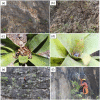Metabarcoding of the phytotelmata of Pseudalcantarea grandis (Bromeliaceae) from an arid zone
- PMID: 35127281
- PMCID: PMC8801176
- DOI: 10.7717/peerj.12706
Metabarcoding of the phytotelmata of Pseudalcantarea grandis (Bromeliaceae) from an arid zone
Abstract
Background: Pseudalcantarea grandis (Schltdl.) Pinzón & Barfuss is a tank bromeliad that grows on cliffs in the southernmost portion of the Chihuahuan desert. Phytotelmata are water bodies formed by plants that function as micro-ecosystems where bacteria, algae, protists, insects, fungi, and some vertebrates can develop. We hypothesized that the bacterial diversity contained in the phytotelma formed in a bromeliad from an arid zone would differ in sites with and without surrounding vegetation. Our study aimed to characterize the bacterial composition and putative metabolic functions in P. grandis phytotelmata collected in vegetated and non-vegetated sites.
Methods: Water from 10 individuals was sampled. Five individuals had abundant surrounding vegetation, and five had little or no vegetation. We extracted DNA and amplified seven hypervariable regions of the 16S gene (V2, V4, V8, V3-6, 7-9). Metabarcoding sequencing was performed on the Ion Torrent PGM platform. Taxonomic identity was assigned by the binning reads and coverage between hit and query from the reference database of at least 90%. Putative metabolic functions of the bacterial families were assigned mainly using the FAPROTAX database. The dominance patterns in each site were visualized with rank/abundance curves using the number of Operational Taxonomic Units (OTUs) per family. A percentage similarity analysis (SIMPER) was used to estimate dissimilarity between the sites. Relationships among bacterial families (identified by the dominance analysis and SIMPER), sites, and their respective putative functions were analyzed with shade plots.
Results: A total of 1.5 million useful bacterial sequences were obtained. Sequences were clustered into OTUs, and taxonomic assignment was conducted using BLAST in the Greengenes databases. Bacterial diversity was 23 phyla, 52 classes, 98 orders, 218 families, and 297 genera. Proteobacteria (37%), Actinobacteria (19%), and Firmicutes (15%) comprised the highest percentage (71%). There was a 68.3% similarity between the two sites at family level, with 149 families shared. Aerobic chemoheterotrophy and fermentation were the main metabolic functions in both sites, followed by ureolysis, nitrate reduction, aromatic compound degradation, and nitrogen fixation. The dominant bacteria shared most of the metabolic functions between sites. Some functions were recorded for one site only and were related to families with the lowest OTUs richness. Bacterial diversity in the P. grandis tanks included dominant phyla and families present at low percentage that could be considered part of a rare biosphere. A rare biosphere can form genetic reservoirs, the local abundance of which depends on external abiotic and biotic factors, while their interactions could favor micro-ecosystem resilience and resistance.
Keywords: 16S; Actinobacteria; Bromeliads; Firmicutes; Functional redundancy; High endemicity; Proteobacteria; Resilience; Taxonomic variation; Water sample.
© 2022 Herrera-García et al.
Conflict of interest statement
The authors declare that they have no competing interests.
Figures





References
-
- Arévalo V. Excavación de galerías de inyección, drenaje e inspección del proyecto 3 hidroeléctrico zimapán. Boletín de la Sociedad Geológica Mexicana. 1991;51(1):3–9.
-
- Benzing DH. Bromeliaceae: profile of an adaptive radiation. Cambridge: Cambridge University Press; 2000.
-
- Bergey DH, Holt JG. Bergey’s manual of determinative bacteriology. ninth Edition. Baltimore: Williams Wilkins; 2005.
-
- Brandt FB, Martinson GO, Conrad R. Bromeliad tanks are unique habitats for microbial communities involved in methane turnover. Plant and Soil. 2016;410(1–2):167–179. doi: 10.1007/s11104-016-2988-9. - DOI
-
- Brozio S, Manson C, Gourevitch E, Burns TJ, Greener MS, Downie JR, Hoskisson PA. Development and application of an eDNA method to detect the critically endangered Trinidad golden tree frog (Phytotriades auratus) in bromeliad phytotelmata. PLOS ONE. 2017;12(2):1–8. doi: 10.1371/journal.pone.0170619. - DOI - PMC - PubMed
Publication types
MeSH terms
Substances
LinkOut - more resources
Full Text Sources
Research Materials

